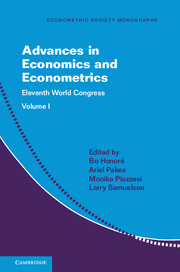Book contents
- Frontmatter
- Contents
- Contributors
- Editors' Note
- 1 Dynamic Mechanism Design: Robustness and Endogenous Types
- 2 Learning, Experimentation, and Information Design
- 3 Dynamic Selection and Reclassification Risk: Theory and Empirics
- 4 Discussion of “Agency Problems”
- 5 Recent Developments in Matching Theory and Their Practical Applications
- 6 What Really Matters in Designing School Choice Mechanisms
- 7 Networks and Markets
- 8 Econometrics of Network Models
- 9 Networks in Economics: Remarks
- Index
6 - What Really Matters in Designing School Choice Mechanisms
Published online by Cambridge University Press: 27 October 2017
- Frontmatter
- Contents
- Contributors
- Editors' Note
- 1 Dynamic Mechanism Design: Robustness and Endogenous Types
- 2 Learning, Experimentation, and Information Design
- 3 Dynamic Selection and Reclassification Risk: Theory and Empirics
- 4 Discussion of “Agency Problems”
- 5 Recent Developments in Matching Theory and Their Practical Applications
- 6 What Really Matters in Designing School Choice Mechanisms
- 7 Networks and Markets
- 8 Econometrics of Network Models
- 9 Networks in Economics: Remarks
- Index
Summary
In the last decade, numerous student assignment systems have been redesigned using input from economists in the large American cities and elsewhere. This article reviews some of these case studies and uses practical experiences to take stock on what has really mattered in school choice mechanism design so far. While some algorithm design details are important, many are less practically important than initially thought. What really matters are basic issues that market operators in other contexts would likely be concerned about: straightforward incentives, transparency, avoiding inefficiency through coordination and well-functioning aftermarkets, and influencing inputs to the design, such as applicant decision-making and the quality of schools.
INTRODUCTION
In recent years, there has been a great deal of research activity and excitement among economists who study the design of systems used to assign students to schools. Motivated by Turkish college admissions, Balinski and Sönmez (1999) first defined the student placement problem, and Abdulkadiroğlu and Sönmez (2003) defined the closely related school choice problem, motivated by K-12 public school admissions in the United States. Both articles showed how insights from matching theory could be used to re-engineer and potentially improve existing centralized school assignment systems. Abdulkadiroğlu and Sönmez (2003) proposed two alternativemechanisms, which are adaptations of widely studied mechanisms in the literature on matching and assignment markets, following seminal contributions by Gale and Shapley (1962) and Shapley and Scarf (1974). Since that article was published, I have been involved in a number of efforts to redesign school choice systems, including those in New York City (2003), Boston (2005), New Orleans (2012), Denver (2012), Washington DC (2013), and Newark (2014). New systems have also been developed in England, Amsterdam, a number of Asian cities, and elsewhere.
The purpose of this article is to review some facts from the field about these redesign efforts and to take stock on what I think has been important in practice so far. This article is not a survey of research on school choice market design (for surveys see, e.g., Pathak, 2011 and Abdulkadiroğlu and Sönmez, 2013). My inspiration comes from Klemperer (2002), who presents his views on what matters for practical auction design based on his experience in designing auctions and advising bidders. Klemperer concludes that “in short, good auction design is mostly good elementary economics,” whereas “most of the extensive auction literature is of second-order importance for practical auction design.”
- Type
- Chapter
- Information
- Advances in Economics and EconometricsEleventh World Congress, pp. 176 - 214Publisher: Cambridge University PressPrint publication year: 2017
- 46
- Cited by

